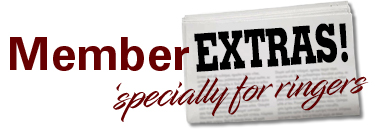Can They Hear You?
By Marilyn Chandler (March/April 2006)
There may be a member of the choir that never seems to know what measure the choir is ringing; has to ask again just after the explanation has been given what technique is to be used in a particular measure; and more often then not, damps their bells incorrectly. It is often assumed that person is not paying attention (sometimes they are not!), but there is also the distinct possibility that person is hearing impaired.
Having been born with a hearing loss (33% in both ears that has gradually worsened) and having been a ringer and director almost 25 years, I would like to share some ideas and suggestions that might make rehearsals much easier for the director, the choir and the ringer who has a hearing impairment. These suggestions address the issues for the ringers with moderate loss and those who wear hearing aids. Modern hearing aids, especially the digitals, are very good, but cannot duplicate God given hearing. Remember too, that people of all ages may be hearing impaired, not just the elderly. Directing methods for the profoundly deaf is a topic for another time and author.
Be aware that some people may not want to share the knowledge of their hearing impairment with everyone. Others may not even know that they have a loss. In either case, it might benefit the director to have a quiet talk with the ringer at another time and place from rehearsal. In the latter case, the director’s comments about their seeming lack of hearing/understanding instructions might help them become aware of their impairment. If the person does confidentially share their loss, assure them that no one else need know without their permission. Be forewarned: many hearing impaired people do quite well and don’t want the stigma of being “handicapped” because they do not feel that they are!
Many of the suggestions that follow may already be a part of the director’s conducting methods. Some may be new ideas for both the ringers and directors. These ideas may not seem too important to the full hearing members of the choir, but they do have great significance for those with a hearing impairment. Directors who have used these suggestions report that time was saved in rehearsals and frustrations were eased for all members of the choir and the director.
The director of the choir sets the tone for how the choir will work with the hearing loss ringer. Whether the ringer is willing to share the loss or not, the director should inform the choir of some possible changes in rehearsals either by just doing them or sharing them verbally. In either case, it can and should be done without excessive attention as to why the changes are occurring. This demeanor not only demonstrates to the other members that the director values every ringer regardless of their ringing expertise or less than perfect physical capabilities, but also validates the honesty and willingness of the hearing loss ringer to be as competent a ringer as possible.
Positioning the Ringer in the Choir
It may be beneficial to place the ringer in the midst of the other members. Ends of tables and sometimes back row positions do not give “surround sound” which will enable the ringer to hear the rest of the choir. This is especially helpful should the ringer lose their place in the music. A ringer in one of my past choirs was deaf in one ear. Her ringing accomplishments were immeasurably improved when she was placed with her hearing ear towards the choir.
The director should become knowledgeable of any pitch problems associated with the ringer’s hearing loss. Most hearing impaired ringers have no limitations as to what bells they can ring. There is, however, a possibility that some ringers may not be able to hear certain bells or whose ears may be sensitive to particular pitches as a result of their hearing aids. Allowing these ringers to ring a variety of bells will help to determine which bells are best for them should these problems occur.
Neither hands nor music should be placed in front of the director’s mouth. Most persons with hearing impairments, whether consciously or unconsciously, read the lips of their director and other choir members. Hands and music should be kept away from the face especially when giving directions.
The pattern needs to be clearly defined. The ringer with a hearing impairment depends heavily on visual directions. Unnecessary movements of the arms or hands makes it very hard for the ringer to ascertain the beat and therefore he/she does not know when to ring. Verbal counting by the director may not always be heard above the sound of the bells depending on the ringer’s level of hearing impairment. The same is especially true of verbal instructions given while the choir is ringing. It is better to wait until the music ceases before reviewing or giving new ideas, suggestions and directions.
When announcing a measure number, use only the words one through nine. For example, say five-six in place of fifty-six (56). Because hearing impairments often make it hard for people to hear certain pitches, they may not, for example, be able to distinguish between the words fifty and sixty. It might take some time and adjustment for everyone in the choir to remember to use this method, but the benefits are enormous. Surprisingly, I have had full hearing ringers tell me this idea was very helpful for them as well.
The director should speak clearly, distinctly and in a non rapid manner. When listening to others, many hearing impaired people hear the vowels and read lips for the consonants. They may not be able to understand directions or questions if the director and other choir members talk too rapidly, mumble or slur words together.
Talking to the Ringer with Hearing Loss Specifically
Call the ringer by their name and wait a moment. He/she will be alerted that the director is talking to them, will respond with eye contact and ready themselves to receive the instructions. If given directions before they are aware they are being spoken to, they may miss much of what is said and most likely will need to have it repeated.
Beginning to Ring
Give the ringers time to locate where in the music you are starting the rehearsal/next section. The hearing impaired ringer may need a moment to process the verbal information given and another moment to find the place the director wishes to begin. Allowing time is especially important when starting at a different place than where the choir just finished ringing. Often done to facilitate the ringers having the correct bells in hand, this moment of time is essential for the hearing impaired person so they, too, can start ringing with the rest of the choir instead of a couple measures later.
Use non-verbal cues to aid the ringer. A nod of the head or eye contact with the hearing loss person can be helpful if the ringer has a position that doesn’t ring for many measures and seems to need an entrance cue, may have an important beginning note or needs to ring out their bells more. The director often employs these methods for all ringers, but they are especially important to the hearing impaired ringer who may not be able to hear the sounds of the whole choir. A word of caution: use these cues sparingly and only when actually needed. Do not let the ringer become too dependent upon the director. Hearing impaired ringers, like all other members of the choir, need to accept the responsibility of depending upon themselves to count inwardly.
Encourage the ringers not to talk when they finish ringing a section or when the director is giving directions or instructions. Hearing impaired ringers (and full hearing ringers!) often find it very hard to hear the director when other ringers converse. It may take a few rehearsals and much patience before the choir members realize the director will not continue directing or give instructions until all the ringers have finished talking. The director should let the choir know when talking periods are acceptable, i.e., when changing to the next piece. If my past experiences are any indication, the other members of the choir will also thank you.
Care should be taken by the director and other ringers not to assist the hearing impaired ringer unless asked and/or no more than they would any other member of the choir. Overzealous assistance may cause the hearing impaired ringer to feel self conscious and frustrated at constantly being told where and what to do. Should the helper try to assist when the ringer has asked the director for information (or when the director is giving information), the hearing impaired ringer will have a hard time hearing the director. As result, he/she loses the opportunity to learn from the director and may find themselves resenting the person trying to help them. Overdone, this help, though meant well, may also create unnecessary disruptions during the rehearsal.
Provide a damping lesson for the whole choir. Very often the hearing impaired person is not aware that their bell is not damped completely. Ask the whole choir to ring one bell, damp it and then immediately move the bell up to their ear. This exercise has surprised many of my full hearing ringers who discovered they hadn’t damped their bell completely either! Follow the exercise with instructions for correct damping and try it again. Be sure to do this with both hands because each ear may have a different level of loss.
If available and the ringer wishes, loan him/her a professional audio tape or CD from a publisher to take home. The hearing impaired ringer may have a very hard time hearing the whole choir. This is a common complaint shared by many full hearing ringers, but it most often is a greater problem for the hearing impaired ringer. Even though the tempo of the CD/tape may be faster than the director wishes to play the piece or the choir is capable of ringing, by listening to the tape and watching their music, the ringer will be able to hear the complete score, hear the melody, and will also gain a sense of where their bells fit in the piece. If feasible, ask the ringer if he/she would like to take bells home to practice with the recording. A recording of the choir playing the piece during one of the first rehearsals could be used instead. These recordings may have notes missing or mistaken notes rung, but a majority of correct notes and the desired tempo should be close enough for the ringer to understand the music and their responsibilities to it.
Your ringer may have other suggestions particular to their impairment or hearing aids. No two situations are the same and therefore beg for different solutions. Encourage the ringer to share their ideas with you and the choir members. Not all of them may be feasible, but others may be truly simple and most beneficial to everyone.
There are instances where the director, such as myself, has a hearing impairment and/or wears hearing aids. It can be most beneficial for the director to share their loss with the choir and ask the ringers to incorporate some of the previously mentioned suggestions in their dialogs with the director. Contrary to what many people might think, youth choir members can be some of the most supportive ringers for a hearing impaired director once the he/she is honest enough to share the information with the youth! The director may have to ask the choir members to take more responsibility with regard to wrong notes played should the director not seem to hear the mistakes. The choir members’ remarks should NOT designate a specific ringer, but rather refer to the measure number. When the director is not sure a chord is being rung correctly, he/she should ask the choir to ring the chord in question, one note at a time, starting with the bass note and letting them all LV to the top note of the chord. Any wrong notes will become apparent very quickly. I have also been known to watch ringers and SEE that they have rung the wrong bell. The latter technique requires the director to thoroughly know the music before them.
This article does not pretend to be the definitive authority on the subject of ringers/directors with a hearing impairment. Hearing losses are as diverse as the people who have them. These ringers/directors may benefit from some or all of these suggestions, or none. The ideas and suggestions presented in this article are results of one person’s experiences and are offered with a hope that they might spark discussions, encourage classes at workshops and/or seminars, and inform and assist those working with hearing impaired ringers/directors.
Do not hesitate to have a person with a hearing impairment in the choir! They can ring (or direct) in a choir as successfully as any person with full hearing. They do not want to be treated any differently from the other ringers, but will appreciate any effort made to use some of these suggestions. He/she will adjust to whatever methods the director implements and will ring as conscientiously as possible to fulfill their responsibilities as a member of the choir. Best of all, they probably will listen more carefully to the director’s instructions and watch the director more than any other ringer in the choir!





